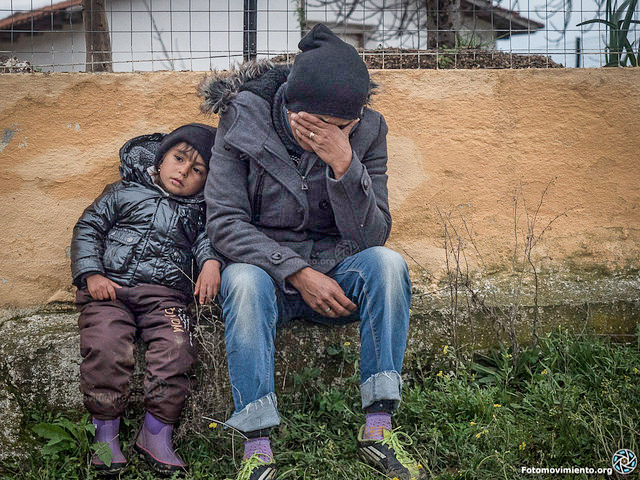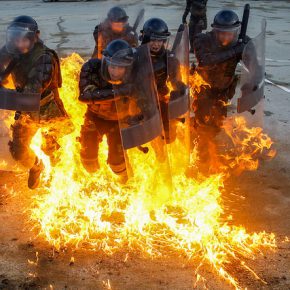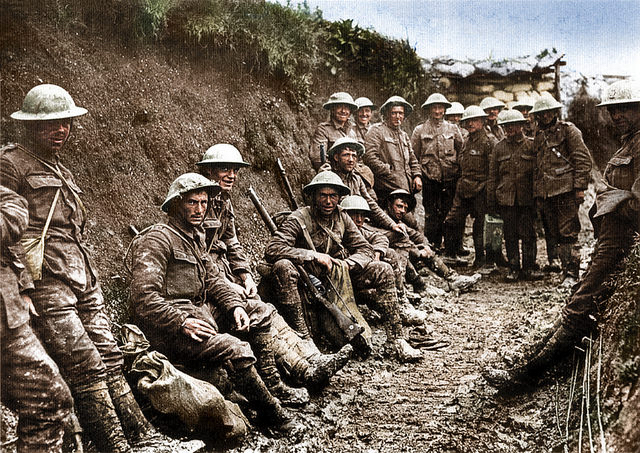Of all perplexing subjects in the world few can be more baffling than the distribution of races in Macedonia. The Turks classify the population, not by language or by physical characteristics, but by religion.
A Greek is a member of the Orthodox Church who recognizes the patriarch of Constantinople; a Bulgarian, on the other hand, is one of the same religious faith who recognizes the exarch; and since the Serbians in Turkey have no independent church but recognize the patriarchate they are often, as opposed to Bulgarians, called Greeks.
Race, being thus merged in religion—in something that rests on the human will and not on physical characteristics fixed by nature—can in that part of the world be changed as easily as religion. A Macedonian may be a Greek today, a Bulgarian to-morrow, and a Serbian next day.
We have all heard of the captain in the comic opera who “in spite of all temptations to belong to other nations” remained an Englishman. There would have been nothing comic in this assertion had the redoubtable captain lived in Macedonia.
In that land a race is a political party composed of members with common customs and religion who stand for a “national idea” which they strenuously endeavour to force on others.
Macedonia is the land of such racial propaganda. As the Turkish government forbids public meetings for political purposes, the propaganda takes an ecclesiastical and linguistic form. Each “race” seeks to convert the people to its faith by the agency of schools and churches, which teach and use its own language.

Up to the middle of the nineteenth century the Greeks, owing to their privileged ecclesiastical position in the Ottoman Empire, had exclusive spiritual and educational jurisdiction over the members of the Orthodox Church in Macedonia. The opposition of the Bulgarians led, as we have already seen, to the establishment in 1870 of the exarchate, that is, of an independent Bulgarian Orthodox Church with the exarch at its head.
The Bulgarian propaganda in Macedonia demanded the appointment of bishops to conduct churches and schools under the authority of the exarchate. In 1891 the Porte conceded Bulgarian bishops to Ochrida and Uskub, in 1894 to Veles and Nevrokop, and in 1898 to Monastir, Strumnitza, and Dibra.
As has been well said, the church of the exarchate was really occupied in creating Bulgarians: it offered to the Slavonic population of Macedonia services and schools conducted in a language which they understood and showed a genuine interest in their education. By 1900 Macedonia had 785 Bulgarian schools, 39,892 pupils, and 1,250 teachers.
The Serbian propaganda in Macedonia was at a disadvantage in comparison with the Bulgarian because it had not a separate ecclesiastical organization. As we have already seen, the orthodox Serbs owe allegiance to the Greek patriarch in Constantinople. And at first they did not push their propaganda as zealously or as successfully as the Bulgarians.
In fact the national aspirations of the people of Serbia had been in the direction of Bosnia and Herzegovina; but after these provinces were assigned to Austria by the Treaty of Berlin, a marked change of attitude occurred in the Serbian government and nation. They now claimed as Serbian the Slavonic population of Macedonia, which hitherto Bulgaria had cultivated as her own.
The course of politics in Bulgaria, notably her embroilment with Russia, inured to the advantage of the Serbian propaganda in Macedonia, which after 1890 made great headway. The Serbian government made liberal contributions for Macedonian schools. And before the nineteenth century closed the Serbian propaganda could claim 178 schools in the vilayets of Saloniki and Monastir and in Uskub with 321 teachers and 7,200 pupils.

These Slav propagandists made serious encroachments upon the Greek cause, which, only a generation earlier, had possessed a practical monopoly in Macedonia. Greek efforts too were for a time almost paralyzed in consequence of the disastrous issue of the Greco-Turkish war in 1897.
Nevertheless in 1901 the Greeks claimed 927 schools in the vilayets of Saloniki and Monastir with 1,397 teachers and 57,607 pupils.
Racial Facts and Fallacies
The more bishops, churches, and schools a nationality could show, the stronger its claim on the reversion of Macedonia when the Turk should be driven out of Europe!
There was no doubt much juggling with statistics. And though Greeks, Serbians, and Bulgarians to satisfy the spiritual and intellectual needs of their kinsmen in Macedonia provided schools and churches, there was always the ulterior (which was generally the dominant) object of staking out claims in the domain soon to drop from the paralyzed hand of the Turk.
The bishops may have been good shepherds of their flocks, but the primary qualification for the office was, I imagine, the gift of aggressive political leadership. The Turkish government now favoured one nationality and now another as the interests of the moment seemed to suggest.
With an impish delight in playing off Slav against Greek and Serbian against Bulgarian, its action on applications for bishoprics was generally taken with a view to embarrassing the rival Christian nationalities. And it could when necessary keep the propagandists within severe limits.

The Bulgarians grew bold after securing so many bishoprics in the nineties and the bishop at Uskub thought to open new schools and churches. But the Turkish governor—the Vali—summoned him and delivered this warning: “O Bulgarian, sit upon the eggs you have, and do not burst your belly by trying to lay more.”
How are we to determine the racial complexion of a country in which race is certified by religion, in which religion is measured by the number of bishops and churches and schools, in which bishops and churches and schools are created and maintained by a propaganda conducted by competing external powers, and in which the results of the propaganda are determined largely by money and men sent from Sofia, Athens, and Belgrade, subject always to the caprice and manipulation of the Sultan’s government at Constantinople?
Personal Observations and Experiences
The difficulty comes when we attempt to give the racial character of Central Macedonia, which is equally remote from Greece, Bulgaria, and Serbia. I travelled through this district last summer. On June 29, when the war broke out between the Allies I found myself in Uskub.
Through the courtesy of the Serbian authorities I was permitted to ride on the first military train which left the city. Descending at Veles I drove across Central Macedonia by way of Prilip to Monastir, spending the first night, for lack of a better bed, in the carriage, which was guarded by Serbian sentries.
From Monastir I motored over execrable roads to Lake Presba and Lake Ochrida and thence beyond the city of Ochrida to Struga on the Black Drin, from which I looked out on the mountains of Albania.
Coming from Athens where for many months I had listened to patriotic stories of the thorough permeation of Macedonia by Greek settlements my first surprise was my inability to discover a Greek majority in Central Macedonia. In most of the cities a fraction of the population indeed is Greek and as a rule the colony is prosperous.

This is especially true in Monastir, which is a stronghold of Greek influence. But while half the population of Monastir is Mohammedan the so-called Bulgarians form the majority of the Christian population, though both Serbians and Romanians have conducted energetic propaganda.
In Veles two-thirds of the population are Christians and nearly all of these are called Bulgarians. In Ochrida the lower town is Mohammedan and the upper Christian, and the Christian population is almost exclusively of the Bulgarian Church.
It does not follow, however, that the people of Central Macedonia, even if Bulgarian churches are in the ascendant among them, are really connected by ties of blood and language with Bulgaria rather than with Serbia. If history is invoked we shall have to admit that under Dushan this region was a part of the Serb empire as under Simeon and Asen it was part of the Bulgarian.
If an appeal is made to anthropology the answer is still uncertain. For while the Mongolian features—broad flat faces, narrow eyes, and straight black hair—which characterize the subjects of King Ferdinand can be seen—I myself have seen them—as far west as Ochrida, they may also be found all over Northern Serbia as far as Belgrade though the Serbian physical type is entirely different.
There is no fixed connection between the anthropological unit and the linguistic or political unit.
Furthermore, while there are well-marked groups who call themselves Serbs or Bulgarians there is a larger population not so clearly differentiated by physique or language. Undoubtedly they are Slavs. But whether Serb or Bulgarian, or intermediate between the two, no one today can demonstrate.
Central Macedonia has its own dialects, any one of which under happy literary auspices might have developed into a separate language. And the men who speak them today can more or less understand either Serbian or Bulgarian.
Hence as the anonymous and highly authoritative author of “Turkey in Europe,” who calls himself Odysseus, declares: “The practical conclusion is that neither Greeks, Serbians, nor Bulgarians have a right to claim Central Macedonia. The fact that they all do so shows how weak each claim must be.”
Adapted from The Balkan Wars 1912-1913, by Jacob Gould Schurman. Photographs courtesy of Fotomovimiento, 7th Army Command, and Seth Frantzman. Published under a Creative Commons license.





